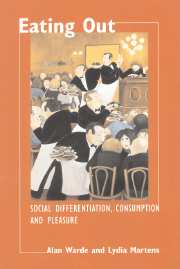Book contents
- Frontmatter
- Contents
- List of illustrations
- List of tables
- Acknowledgements
- 1 Studying eating out
- Part I Modes of provision
- Part II Access
- Part III Delivery
- 6 Personal service in public and private settings
- 7 Last suppers
- Part IV Enjoyment: the attractions of eating out
- Part V Conclusion
- Methodological appendix: data collection and analysis
- References
- Index
6 - Personal service in public and private settings
Published online by Cambridge University Press: 22 September 2009
- Frontmatter
- Contents
- List of illustrations
- List of tables
- Acknowledgements
- 1 Studying eating out
- Part I Modes of provision
- Part II Access
- Part III Delivery
- 6 Personal service in public and private settings
- 7 Last suppers
- Part IV Enjoyment: the attractions of eating out
- Part V Conclusion
- Methodological appendix: data collection and analysis
- References
- Index
Summary
Although not a topic receiving a great deal of scholarly attention, several commentators have regarded the restaurant and the hotel dining room as sites of social control and discipline. Mostly this has been a matter of the strategies that staff or management use to obtain maximum desired compliance from clientele, it being not enough for customers to spend money, for they must also behave in an acceptable fashion. Contrary to any presumption of consumer sovereignty, some accounts (especially Whyte, 1948; Mars and Nicod, 1984) suggest that waiters are adept at manipulating their customers, and that there are some unpleasant punishments for those who resist. Finkelstein (1989) implies that control is built into the design of a restaurant, such that its ‘diorama’, or ambience, serves to prescribe customer behaviour. Wood (1994b), probably more sanguine than Finkelstein, observes that there is a genuine problem of appropriate interaction between providers and consumers of commercial hospitality services, and seeks to isolate some of the ritual rules involved and to explore how these have developed over time, such that behaviour in dining rooms is, for the most part, orderly and predictable. However, he notes elsewhere (Wood, 1990) that the restaurant is a masculine environment, implying that male diners (and managers) exercise some degree of power and control over women.
This chapter explores these propositions regarding the operation of power, examining whether people feel restrained, constrained and repressed; if so by what or by whom.
- Type
- Chapter
- Information
- Eating OutSocial Differentiation, Consumption and Pleasure, pp. 117 - 134Publisher: Cambridge University PressPrint publication year: 2000



